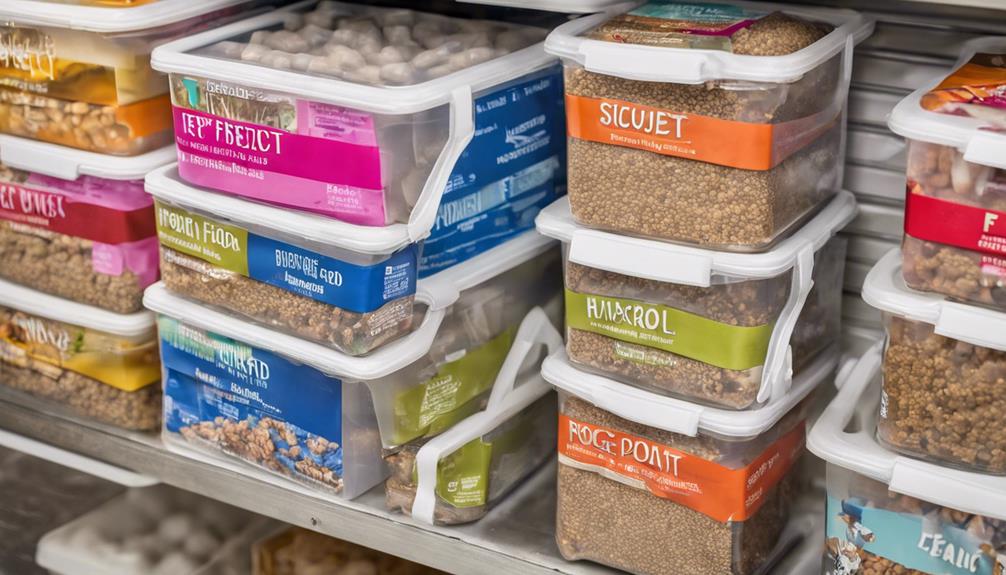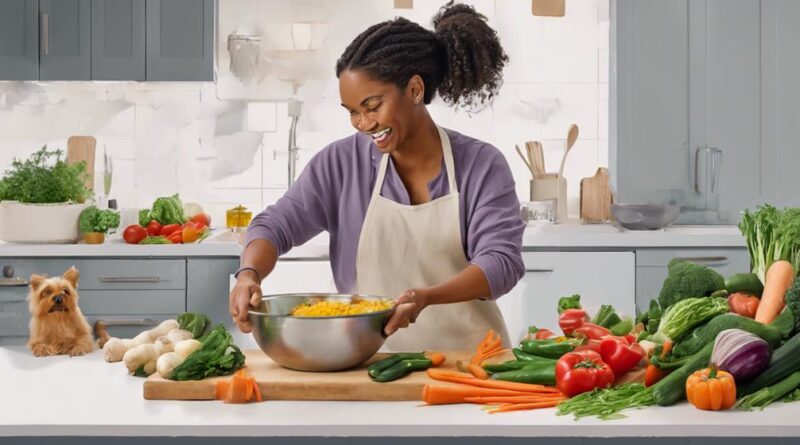9 Best Tips for Preparing Homemade Dog Food
When it comes to your furry companion's diet, you want to ensure you're providing the best care possible. Homemade dog food can be a great option, but it requires careful planning and consideration.
From selecting the right ingredients to cooking methods, there are essential tips to keep in mind to keep your pup healthy and happy.
Let's explore how you can create nutritious meals that your dog will love and benefit from.
Choose Quality Ingredients
When preparing homemade dog food, ensure you choose quality ingredients. Ingredient sourcing plays a vital role in the overall health and well-being of your furry friend. Opt for fresh, high-quality meats, vegetables, and grains to provide essential nutrients. Consider budgeting wisely by purchasing in bulk or looking for deals at local markets to save money without compromising on quality.
Recipe experimentation is key to finding the perfect balance of flavors and nutrients for your dog. Try different combinations of ingredients to see what your pup enjoys the most. Taste testing is crucial to ensure that the final dish isn't only nutritious but also delicious for your dog. Make adjustments as needed based on their preferences and nutritional needs.
Balance Nutritional Needs
To ensure your homemade dog food meets all the nutritional requirements for your furry companion, focus on balancing essential nutrients in their diet. Here are some key points to keep in mind:
- Portion Control and Meal Frequency: It's crucial to provide the right amount of food for your dog based on their size, age, and activity level. Dividing their daily intake into appropriate meals throughout the day helps maintain steady energy levels and aids digestion.
- Allergies and Supplements: Be aware of any food allergies your dog may have and tailor their diet accordingly. Introducing new ingredients gradually can help identify and avoid potential allergens. Additionally, consider incorporating supplements like vitamins or minerals to address any nutritional gaps in their diet, but always consult with a vet before adding any supplements to ensure they're safe and beneficial for your dog's health.
Consult With a Vet
For optimal guidance on preparing homemade dog food, consult a vet to ensure your furry friend's nutritional needs are met effectively. Vets can provide valuable insights into dietary restrictions and help you make necessary recipe adjustments to tailor meals specifically for your dog. If your pet has allergies, a vet can recommend suitable ingredient substitutions to prevent any adverse reactions. They can also advise on the appropriate balance of nutrients to promote your dog's overall health and well-being.
When consulting with a vet about homemade dog food, be sure to share your recipes and meal plans. Vets can analyze these to determine if they meet your dog's requirements or if modifications are needed. By working closely with a vet, you can create a personalized diet that caters to your dog's unique nutritional needs. Additionally, vets can offer guidance on portion sizes, feeding schedules, and any supplements that may be necessary to ensure your dog receives all essential nutrients. Consulting with a vet is crucial in crafting a homemade dog food diet that's both nutritious and safe for your beloved pet.
Avoid Harmful Foods
Ensure your homemade dog food remains safe and nutritious by being aware of foods that can be harmful to your furry companion. When preparing meals for your dog, keep the following points in mind:
- Ingredient substitutions: Some ingredients that are safe for humans can be toxic to dogs. Avoid using foods like chocolate, grapes, raisins, onions, garlic, and certain nuts in your dog's meals. Opt for safe alternatives such as blueberries, apples (without seeds), carrots, and lean meats like chicken or turkey.
- Safe food handling: Just like with human food, proper food handling is crucial when preparing homemade dog meals. Wash your hands before and after handling ingredients, ensure all cooking utensils are clean, and store ingredients properly to prevent contamination.
- Consult with a vet: If you're unsure about the safety of a particular ingredient or recipe, always consult with your vet. They can provide guidance on suitable foods for your dog's specific dietary needs and any potential harmful ingredients to avoid.
Incorporate Variety
Consider mixing up your furry friend's meals with a variety of ingredients to keep their diet interesting and balanced. Dogs, like humans, enjoy a change in their meals. Experiment with different flavor combinations to entice your pup's taste buds. For example, mix chicken with sweet potatoes one day and beef with carrots the next. This not only adds excitement to mealtime but also provides a range of nutrients for their overall health.
Additionally, pay attention to your dog's texture preferences. Some dogs may prefer softer foods, while others enjoy a crunchier consistency. Incorporating a mix of textures can make mealtime more enjoyable for your pet. For instance, combine cooked rice with raw vegetables or add some chopped fruits to their meat mixture. By offering a variety of textures, you can cater to your dog's preferences and make mealtime a delightful experience for them.
Cook Thoroughly
To ensure your homemade dog food is safe and nutritious, make sure to thoroughly cook all ingredients before serving them to your furry companion. Proper cooking is essential to eliminate harmful bacteria and parasites that could be present in raw ingredients, ensuring your dog's health and well-being.
When sourcing ingredients for your homemade dog food, opt for high-quality, fresh produce and meats to provide the best nutrition for your pet. Here are three key points to consider when it comes to cooking homemade dog food:
- Thoroughly Cook Meats: Cooking meats at the right temperature for the correct duration is crucial to kill any potential pathogens and make the protein more digestible for your dog.
- Steam Vegetables: Steaming vegetables is a great cooking method to retain their nutrients while making them easier for your dog to digest.
- Avoid Seasonings: When cooking for your dog, refrain from using seasonings like garlic, onion, or excessive salt, as these can be harmful to your pet's health.
Store Properly

Properly storing homemade dog food is essential to maintain its freshness and nutritional value for your pet. To ensure your dog's food stays safe and nutritious, follow these key tips for proper storage.
Firstly, store the homemade dog food in airtight containers in the refrigerator to maintain its freshness. This helps prevent spoilage and maintains the food's quality for a longer period. Remember to label the containers with the date of preparation to keep track of the shelf life and ensure you use the food before it spoils. Additionally, freezing portions of homemade dog food can extend its shelf life further, preserving its nutrients for your pet.
When it comes to preventing spoilage and ensuring food safety, always follow proper storage guidelines. Make sure to refrigerate or freeze any leftovers promptly to avoid bacterial growth. Proper storage not only maintains the taste and texture of the homemade dog food but also keeps it safe for your furry friend to enjoy. By following these storage tips, you can provide your pet with fresh and nutritious homemade meals while ensuring their safety and well-being.
Transition Slowly
To ensure a smooth adjustment for your pet, gradually introduce the homemade dog food into their diet. This approach helps prevent digestive upsets and allows your dog's system to adapt to the new diet effectively. Transitioning slowly also gives you the opportunity to monitor any potential allergies or sensitivities your pet might have to specific ingredients in the homemade food.
Key Points for Transitioning Slowly:
- Gradual Introduction: Start by mixing a small amount of homemade dog food with your pet's current food. Slowly increase the proportion of homemade food over the course of a week or two to allow for a gentle transition.
- Health Benefits: By transitioning slowly, you can observe how your dog responds to the homemade diet. This method enables you to assess any positive changes in their health, such as improved coat condition, energy levels, and digestion.
- Meal Planning, Ingredient Sourcing: Use this transition period to plan your dog's meals and ensure you have a reliable source of high-quality ingredients for their homemade food. This careful planning contributes to the overall health and well-being of your furry companion.
Frequently Asked Questions
Can I Use Raw Meat in Homemade Dog Food Recipes?
You can use raw meat in homemade dog food recipes, but it's important to be cautious. Cooking methods are vital for safety. Health risks may include bacterial contamination, so ensure proper handling.
Benefits of raw meat can include better nutrient retention. Just remember to research safe practices and consult with a vet to ensure your dog's diet meets their nutritional needs.
How Can I Ensure That My Homemade Dog Food Is Meeting All of My Dog's Nutritional Needs?
To ensure your homemade dog food meets all your dog's nutritional needs, focus on achieving a proper balance of nutrients.
Use a variety of protein sources in your homemade dog food recipes to provide essential amino acids. This can include lean meats, fish, eggs, and legumes.
Are There Any Specific Supplements I Should Add to Homemade Dog Food?
When considering supplement recommendations for homemade dog food, it's essential to prioritize your dog's health. Ensuring your furry friend gets all the necessary nutrients is crucial. Be cautious with vitamin and mineral levels to prevent deficiencies or overdosing.
Always consult with a veterinarian for guidance on the right supplements to add for your dog's specific needs. Prioritize homemade dog food safety by following recommended guidelines and using quality ingredients.
How Often Should I Consult With a Vet About My Dog's Homemade Diet?
You should consult with a vet regularly about your dog's homemade diet. Ensuring nutritional balance and monitoring for any health concerns are crucial.
Don't hesitate to seek vet advice whenever you have questions or notice changes in your dog's health. Your vet can provide guidance on how to tailor the homemade food to meet your dog's specific needs and address any potential deficiencies.
Regular check-ins will help keep your furry friend healthy and happy.
Can I Include Grains in My Homemade Dog Food Recipes?
You can absolutely include grains in your homemade dog food recipes as long as you consider grain alternatives like quinoa or brown rice. These can provide essential nutrients for your pup.
Don't forget to balance it out with quality protein sources like chicken or fish. Keep in mind your furry friend's dietary needs and consult with a vet to ensure a well-rounded diet that meets their requirements.
Conclusion
In conclusion, preparing homemade dog food can be a rewarding way to ensure your furry friend gets the best nutrition possible. By following these tips, you can create balanced and healthy meals for your pup.
Remember to consult with a vet to tailor the diet to your dog's specific needs, and always prioritize quality ingredients and proper cooking techniques.
Your dog will thank you for the delicious and nutritious meals!
